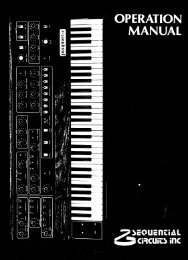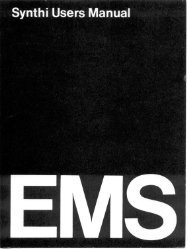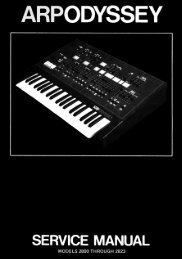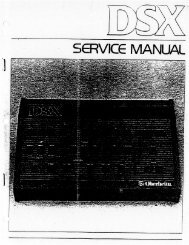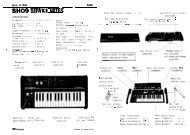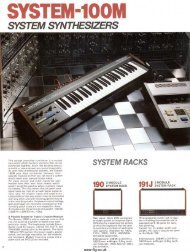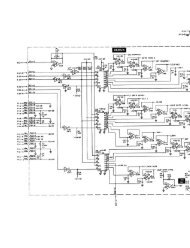ARP2600 - Fundamentals of Music Technology - Cyborgstudio.com
ARP2600 - Fundamentals of Music Technology - Cyborgstudio.com
ARP2600 - Fundamentals of Music Technology - Cyborgstudio.com
Create successful ePaper yourself
Turn your PDF publications into a flip-book with our unique Google optimized e-Paper software.
SECTION9 MIXER SECTIONTHE MIXERThe mixer section is a module <strong>of</strong> the synthesizer that has been used almostsince the beginning <strong>of</strong> this book, but has yet to be explained fully. The mixersection is one <strong>of</strong> the most simple modules, and easiest modules to understand.The mixer performs a simple task: it <strong>com</strong>bines two different signalsand prepares them for output to the ARP 2600’s internal amplifier. One cansee in Figure 9-1 that the mixer features two audio inputs. Each one featuresan attenuation slider so that the signals can be <strong>com</strong>bined at the desired levels.Note that the outputs <strong>of</strong> the VCF and VCA are normalled to the mixer’sinputs. This makes sense, since these are the two modules most likely to beat the end <strong>of</strong> the signal chain <strong>of</strong> a patch (not counting the mixer section,which has to be at the end <strong>of</strong> every patch if one wants to hear any sound atall).The mixer’s signal flow is easy to see by following the white lines screenedon the ARP’s front panel. One can see in Figure 9-1 that first, each inputleads to a separate jack. Unfortunately, there is no mention <strong>of</strong> the function <strong>of</strong>these jacks anywhere in the ARP 2600’s user manual. (A copy <strong>of</strong> the author’suser manual is available on-line at http://www.EmusicDIY.<strong>com</strong>/arp/pages.)These jacks aren’t labeled, which makes it rather difficult to discover theirpurpose. Careful inspection <strong>of</strong> the 2600’s schematics reveal that these jacksare individual outputs. These jacks pass a copy <strong>of</strong> whatever <strong>com</strong>es in eachinput back out. However, when a plug is inserted into them, they cut <strong>of</strong>f thesignal flowing to the mixer and then to the amplifier and speakers. One mightthink that this would render them <strong>com</strong>pletely useless, but this is not reallyso. They allow either <strong>of</strong> the sliders on the mixer to be used to attenuate audioor control signals independently <strong>of</strong> any other module.Figure 9-1: The mixer sectionIt is interesting to note that while the mixer has been used exclusively for audio signals to this point, itis possible to use it to mix control signals as well. This technique is <strong>of</strong> rather dubious value, however,since the mixer’s ability to mix and attenuate in<strong>com</strong>ing audio signals is lost when it is used with controlvoltages. There are modules better suited to this task which will be explored in the next section.PANNINGIn the next part <strong>of</strong> the mixer, the white lines converge and meet at one output. This is where the actualmixing occurs. Whatever is input to the mixer’s two channels appears here at this single output. However,this jack is more than an output. It is also an input. In<strong>com</strong>ing signals are fed to the next part <strong>of</strong> themixer: the PAN control. Pan is an abbreviation <strong>of</strong> the term panoramic potentiometer. The PAN controlsimply determines the amount <strong>of</strong> signal which is going to each output, and to each speaker. When the070




